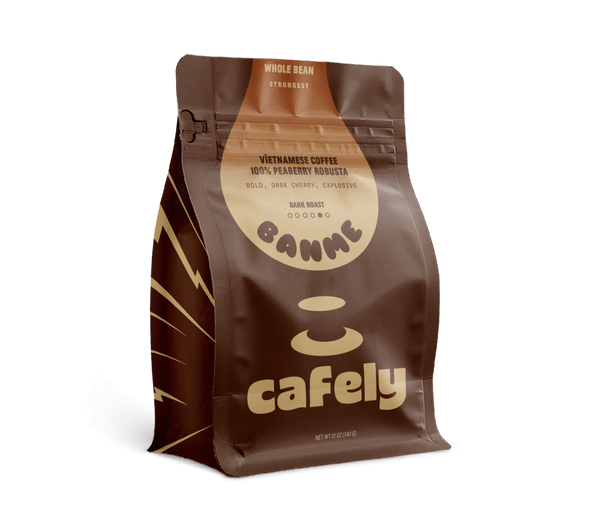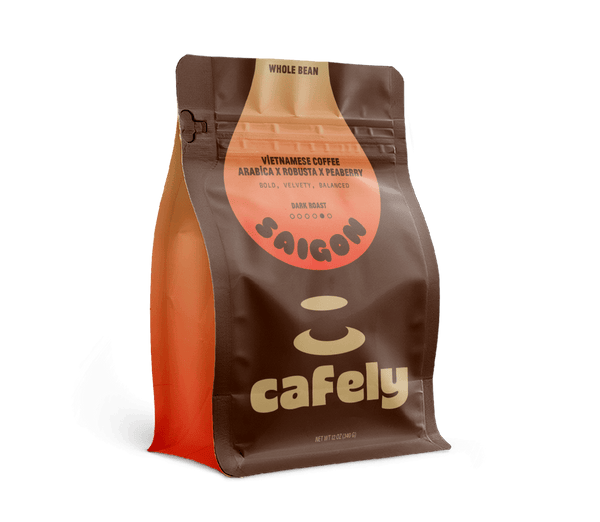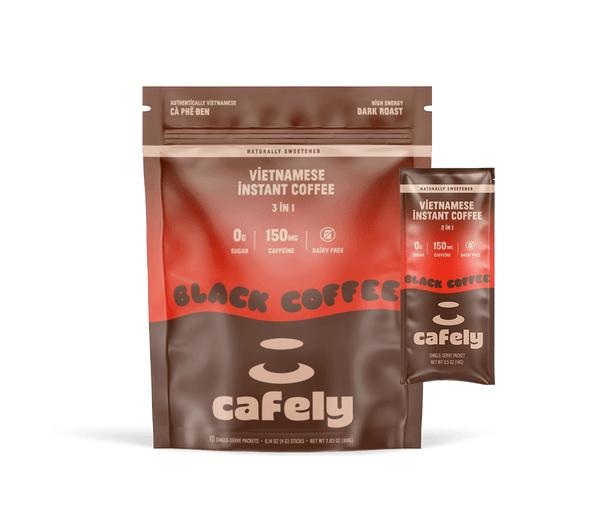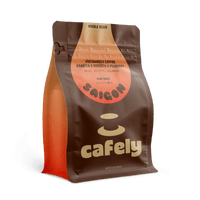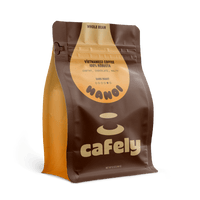A phin filter is a small, traditional Vietnamese drip-style brewer made of metal. It’s the ideal brewing method for the strong and bold flavors of Vietnamese robusta coffee. This device is cheap, easy to use, and only takes a few minutes to produce a strong and delicious cup of coffee.
A phin filter has 4 parts — a chamber for ground coffee, a perforated filter plate, a gravity press to compact the coffee, and a lid to retain heat during brewing.
Phin Brewing Specs
- Brew Time: 5–8 minutes
- Coffee/Water Ratio: 1:2
- Grind: Fine Grind (Like Sand)
- Water Temperature: 200ºF (93ºC)
- Recommended Coffee: Saigon OG, Hanoi
Phin Filter Brewing Summary
- Measure & grind your coffee.
- Assemble your phin filter.
- Add coffee to your phin chamber.
- Gently tamp & even your coffee using the gravity press.
- Pour hot water to the fill line of your phin.
- Wait for your coffee to finish brewing (5–7 minutes).
- Add ice & sweetener.
Tools You’ll Need
To brew coffee using a traditional Vietnamese phin filter, you’ll need the following items/ingredients:
- Phin Filter — The traditional phin filter is a small stainless steel device that eliminates the need for paper filters, specialty components, and electricity.
- High-Quality Vietnamese Coffee — Opt for a freshly roasted Coffea robusta for best results. The stronger, the better.
- Sweetened Condensed Milk — Canned condensed milk provides the rich sweetness necessary to balance the strong, bold flavors of dark-roasted Vietnamese robusta. You'll need roughly 2 tablespoons (30 mL) for every 5 oz (148 mL) of coffee. Adjust levels to taste.
- Coffee Grinder — A burr grinder will provide the best grind consistency, but a blade grinder or a small blender will do the trick too. Aim for a fine grind with a coarseness similar to sand.
- Hot Water — For phin filters, you’ll want to opt for a ratio of around 1:2 or 1:4 coffee to water. The total amount of water will depend on the size of your phin kit.
- Ice (Optional) — For traditional Vietnamese-style iced coffee, fill your cup to the brim with ice and pour the freshly brewed coffee overtop once it’s finished brewing. Skip this ingredient if you’re going for a cup of hot coffee.
- Heat Resistant Mug or Glass Cup — If using a glass cup (as-is traditional for Vietnamese iced coffee), make sure it's heat-resistant. The final brew will be cold, but you'll still need to use hot coffee for the first pour.
Phin Filter Sizing
Phin filters are available in all different sizes. The smallest are single-serving 4 oz filters; the largest rarely exceed 24 ounces. We like the standard 6 oz for preparing 1–2 cups of coffee at a time.
|
Phin Filter Size |
Servings |
Coffee |
|
4 oz Phin (XS) |
1 serving |
2 tablespoons (14 grams) |
|
6 oz Phin (S) |
1–2 servings |
3 tablespoons (21 grams) |
|
8 oz Phin (M) |
2–3 servings |
4 tablespoons (28 grams) |
|
12 oz Phin (L) |
3–4 servings |
6 tablespoons (42 grams) |
|
24 oz (XL) |
4–6 servings |
12 tablespoons (84 grams) |
Step-By-Step Instructions: Vietnamese Phin Filter
Here's a simple process for brewing coffee using authentic Vietnamese phin filters.
Note: Coffee is a personal experience, so there's no wrong way to prepare it. The guide below provides ideal ratios and steps for making traditional Vietnamese-style coffee with a phin filter — but feel free to make it your own using different water and condensed milk ratios or add ingredients like vanilla, cinnamon, or chocolate to enhance the flavor.
Step 1: Measure & Grind the Coffee

The amount of coffee you'll need will depend on the size of your phin filter. Use a coffee grinder to prepare whole beans, or use a bag of our pre-ground coffee to skip this step entirely. Our Saigon OG and Hanoi blends come pre-ground in the perfect consistency for using a phin filter.
If grinding coffee yourself, use the fine-ground setting (similar consistency to sand). Giving your coffee a quick spray with water using a spray bottle is optional but dramatically improves the grind consistency of the coffee.
Step 2: Assemble the Phin Filter

Grab your phin filter and a mug or heat-resistant glass cup. Place the filter plate on top of the cup, then add the brew chamber.
The gravity press and lid will go on later, so keep these nearby.
Step 3: Add Coffee Grounds

Add your Vietnamese coffee of choice to the chamber according to the size of your phin filter. For single-servings, start with the 6 oz filter and add about 21 grams (3 tablespoons) of coffee.
Step 4: Add the Gravity Press

Shake your filter to even the coffee grounds and add the gravity press, using very light pressure to ensure an even distribution.
Step 5: Add The Water

To optimize the flavor of your coffee when using a phin filter, you should add water in two separate stages.
First, the bloom stage — add just enough hot water to cover about ½ inch (1-2 cm) above the top of the gravity press. Wait 45 seconds to allow all the gases to escape the grounds.
Second, the brewing stage — Fill the water to just below the brim of the filter.
Step 6: Wait For Your Brew to Finish Dripping

Once the water is added, place the lid on top and wait for the cycle to finish. It can take up to 2 minutes for the first drops to appear and about 5 minutes for the total brewing process to complete. Larger phin filters may require more time (up to 7 minutes).
Step 7: Add Sweetener
Traditional Vietnamese coffee calls for sweetened condensed milk, but you can also use regular milk, sugar, or other creamers to sweeten. We use about 2 tablespoons (1 oz) of condensed milk but feel free to play around with this to your liking.
Step 8: Add Ice (Optional)

To make iced Vietnamese coffee, add enough ice to bring the volume up to the top of your mug. The more ice, the better to bring the core temperature of the coffee down as quickly as possible. Let your coffee sit for about 1–2 minutes before drinking so it’s nice and cool.
Expert Tips For Brewing With A Vietnamese Phin Filter
There's no need to overcomplicate the process — the beauty of the phin filter is its simplicity and ability to make delicious coffee without any fuss. However, there are a few tips to help you get the most out of your brew.
1. Don’t Forget the Bloom Stage!
Adding water in two separate intervals may feel tedious and unnecessary, but trust us when we say it will improve the quality of your final brew substantially. Allowing the gases to escape between the grounds will ensure a complete and even extraction. This step helps cut down bitterness and makes it less likely for your extraction to stall.
2. Don’t Press Too Hard With the Gravity Press
The gravity press helps ensure the coffee is evenly distributed and ensures a more even extraction. If you press down too hard, it could prevent water from passing through the grounds, leading to a stall (the water will no longer flow through the coffee).
3. Use Plenty of Ice
When we prepare our phin coffee, we like to fill a cup with ice to the brim and then pour the freshly brewed coffee over the top to allow it to cool more quickly. So make sure you use a mug that's larger than you think you need if brewing iced coffee.
4. Use a Glass Cup For Added Visual Effect
This tip doesn't change the flavor of the coffee, but it does enhance the distinct look of Vietnamese iced coffee. We believe this look adds a lot to the experience. Authentic Vietnamese coffee connoisseurs usually add the condensed milk first at the bottom of the cup, then ice, then pour the coffee overtop. This creates a beautifully layered effect. Appreciate, then stir to combine everything together.
History of the Phin Filter
The phin filter represents a blend between the industriousness and adaptability of the Vietnamese culture and the French, who colonized Vietnam from 1858 to 1954.
Soon after the French arrived in Vietnam, they brought their love for coffee along with them. Vietnamese farms started growing coffee around the country, but the Coffea arabica beans the French brought with them struggled to thrive in the lower altitudes of Vietnam. Aside from the central mountains of the central highlands, most farms cultivating arabica beans in lowland areas produced an undesirable acidity. Farmers adapted by planting the Coffea robusta bean instead, thriving in lower altitudes and lacking acidic tastes.
The phin was invented sometime in the 19th century and quickly rose to become the standard brew system for the Vietnamese. This tool is cheap and strong enough to endure a lifetime of use. It's perfectly suited to the stronger, more robust flavor profile of robusta coffee.
Today, the phin filter is the standard brewing system for preparing authentic Vietnamese-style coffee.
FAQs & Troubleshooting: Vietnamese Phin Filter
1. What type of coffee grind should I use with a Phin filter?
A medium to medium-fine grind works best with a Phin filter. Too fine a grind can cause the water to flow through too slowly or clog the filter, while too coarse a grind may result in a weak brew.
2. How much coffee should I use in a Phin filter?
For a standard-sized Phin filter (around 4 ounces), it's recommended to use about 14 grams (roughly 2 tablespoons) of coffee. This can be adjusted based on personal preference to increase or decrease strength.
3. What is the ideal water temperature for brewing with a Phin filter?
The ideal water temperature for brewing with a Phin filter is between 195°F to 205°F (90°C to 96°C). Water that's too hot can extract unwanted bitterness, while cooler water might not extract enough flavor or produce an overly sour coffee.
4. How long does it take to brew coffee with a Phin filter?
The brewing process with a Phin filter typically takes about 4 to 7 minutes, depending on the amount of coffee used, the grind size, the size of your phin, and how tightly the coffee is packed.
5. Why is my Phin filter brewing too fast or too slow?
If your Phin filter brews too fast, the grind may be too coarse, or the coffee may not be packed tightly enough. If it brews too slowly, the grind might be too fine, or the coffee could be packed too tightly. Adjusting the grind size or the amount of coffee can help achieve the desired flow rate.
6. Can I reuse coffee grounds in a Phin filter?
While you can technically reuse coffee grounds, the second brew will be significantly weaker and lack the depth of flavor of the first brew. It's recommended to use fresh grounds for each brew for the best taste.
7. How do I clean my Phin filter?
After each use, disassemble the Phin filter and rinse each part with warm water. Ensure that all coffee grounds are removed from the filter. For a deeper clean, use mild soap and water, but make sure to rinse thoroughly afterward to remove any soap residue.
8. Can I make anything other than coffee with a Phin filter?
The Phin filter is designed specifically for brewing coffee. While it's technically possible to brew loose-leaf teas, this is not recommended. Tea is best brewed using dedicated immersion tea steepers.
9. What makes Vietnamese coffee using a Phin filter unique?
Vietnamese coffee brewed with a Phin filter is known for its strong, robust flavor, often complemented by sweetened condensed milk and ice. The slow drip process the Phin provides, ensures a full extraction of flavors. It produces a distinctive, bold, and smooth cup of coffee characteristic of the Vietnamese coffee tradition.
